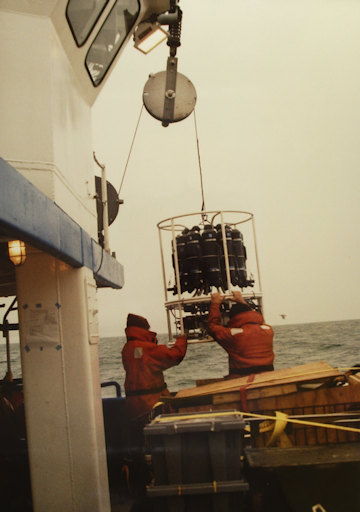LITERATURE ABOUT THE THE GULF OF MAINE
Literature about the Gulf of Maine

Deploying the CTD/Rosette on a cold day for water samples. (photo by J.Christensen.)
The Gulf of Maine
The highly productive Gulf of Maine has maintained a rich biological community in its waters and within the sediments. Our scientists have ongoing efforts here. We discovered through studies of the sediments (reference A below) that the Gulf’s sediments receive 20-33% of the annual plant production, and that the proportion of the productivity reaching the sediments decreases with increased water depth. Following this reasoning, in reference B, we showed that respiration rates of microplankton in the water column (those plankton of about the size of 0.4 – 10 micrometers) also decreased at increasing water depths. We showed that nitrogen loss within the sediments (via denitrification) is a key process limiting plant productivity in the Gulf (reference C). We have been investigating the causes and impacts of ocean acidification in the Gulf (see reference D below). Also, we examined whether a trace constituent of seawater, bromide, may be impacted by macroalgal growth along the Maine shoreline (reference E).
A – Sulfate reduction and carbon oxidation in Gulf of Maine sediments
B – Respiration and the vertical carbon flux in the Gulf of Maine.
C – Water column nutrients and sediments in the Gulf of Maine.
D – Seawater affecting zooplankton hatching under ocean acidification.
E – Bromine depletion in the Gulf of Maine.
